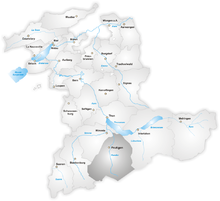Frutland
The Frutigland is a region south of Lake Thun in the western Bernese Oberland in Switzerland .
geography
The Frutigland essentially consists of the catchment area of the Kander (Aare) : the north-south running Frutigtal and Kandertal and its side valleys: the side valleys Engstligental , Üschinental, and Schwarzbachtal in the west, Kiental , Suldtal , Öschinental and Gasterental in the east.
More important localities in Frutigland are Adelboden , Frutigen , Kandersteg and Reichenbach in the Kandertal .
The typical form of settlement in the Frutigland are farmhouses in scattered settlements , which are organized in farmers ; the typical farm in the area is the Frutighaus .
history
In the Middle Ages, traffic to the Valais via the Gemmipass or Lötschbergpass through the Frutigland; However, these inhospitable passes were not an attraction for visitors and the Frutigland was rather poor, in contrast to the neighboring Simmental with the transition to the Saanenland and the Rawilpass.
Historically, the Frutland consisted of the Freiherrschaft Frutenland (Upper Kandertal and Engstligental) and the Freiherrschaft Mülenen (Lower Kandertal), in the High Middle Ages both owned by the Barons of Kien. In 1400 the Frutigland was sold to the city of Bern. In 1798 Frutigen became the district of Frutigen in the canton of Bern. Since the dissolution of the Bernese districts on December 31, 2009, Frutigland has been part of the Frutigen-Niedersimmental administrative district , with Frutigen as the main town.
Frutenland was already pietistic in the 18th century, and traditional Protestant free churches are still firmly anchored in the population today. In the 18th century the Heimberger Brothers, a Pietist revival movement in the Reformed regional church, had a strong popularity, in the 19th century both the neo-Pietist revival of the Evangelical Society of the Bern Regional Church and the Bernese Brethren movement, which was split off from it, today represented by the more conservative community for Christ and the more open Free Mission Churches . At that time, the mission of the Methodist Evangelical Community (now part of the Methodist Church ) found many followers there.
economy
Up until well into the 19th century, cattle breeding was the economic backbone of the area, with agriculture and alpine farming differing in some respects from that of the surrounding area: The cheese wheels of alpine cheese are smaller; the Alps are mostly cultivated by locals who also have a farm in the valley; bulls are often kept for breeding purposes in the Alps. Cheese is still produced in 130 Alps in the Frutigland. In the livestock and sheep played a big role, whose wool was processed until the 19th century in the valley to the black Frutigland cloth for Berner costumes was much in demand.
Slate mining also played a role well into the 20th century, as did match manufacture, with the matchboxes being made by poor mountain farmers at home.
Today tourism plays an essential role in the economy; In contrast to other regions, however, the culture and the population in Frutigland are still shaped by agriculture.
In terms of traffic, the Frutigland is nowadays accessible through the Lötschberg line with the car train in Kandersteg.
literature
- Klaus Jürg Aellig: The economic situation in Frutigland with special consideration of tourism. 1957.
- Sigi Amstutz, Christian Bärtschi, Käti Jaberg: Here is always: pictures and texts from their time; Works by the painter Angelo Molinari. Imfeld 2011, ISBN 978-3-907041-46-8 .
- Christian Bärtschi: Ds drizzle. Erlabts un Ersinets us em Frutigtal. Egger, Frutigen 2014, ISBN 978-3-9520760-8-8 .
- Josy Doyon: Gray gold. Story about slate mining in the Engstligental. Blaukreuz, Bern 1976, ISBN 3-85580-054-5 .
- Maria Lauber : Under the crowned eagle: the Frutigen valley. 1961.
- Isn't my valley emitts. Maria Lauber (1891–1973). Reading book. Edited by the Frutigland Cultural Property Foundation. Zytglogge, Bern 2016.
- Ernst Roth: z'Bärg in Frutigland. 130 Cheese Alps of the Frutigen Office. 2005.
- Karl Stettler: The Frutigland. The Bernese district of Frutigen illuminated in all directions in bound and unbound speech . 1887.
Web links
- Anne-Marie Dubler : Frutigen (rule, administrative district). In: Historical Lexicon of Switzerland .
Tschingelsee in the Kiental






